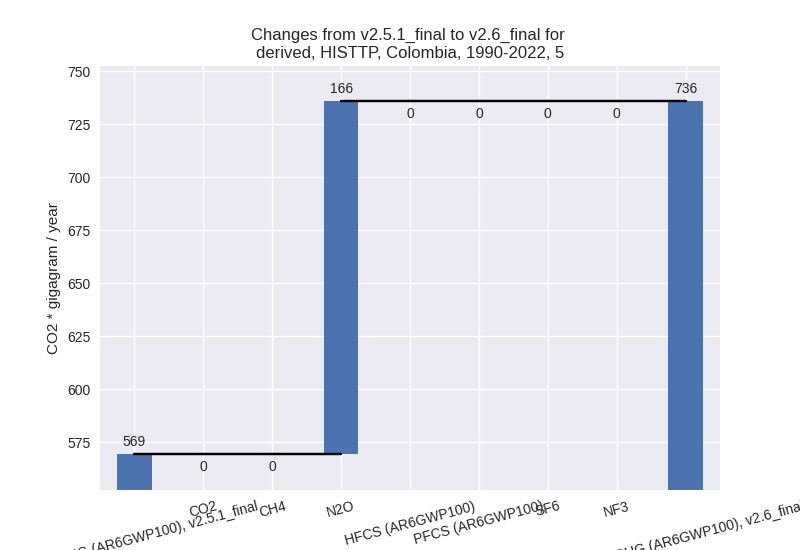Changes in PRIMAP-hist v2.6_final compared to v2.5.1_final for Colombia
2024-09-24
Johannes Gütschow
Change analysis for Colombia for PRIMAP-hist v2.6_final compared to v2.5.1_final
Overview over emissions by sector and gas
The following figures show the aggregate national total emissions excluding LULUCF AR6GWP100 for the country reported priority scenario. The dotted linesshow the v2.5.1_final data.
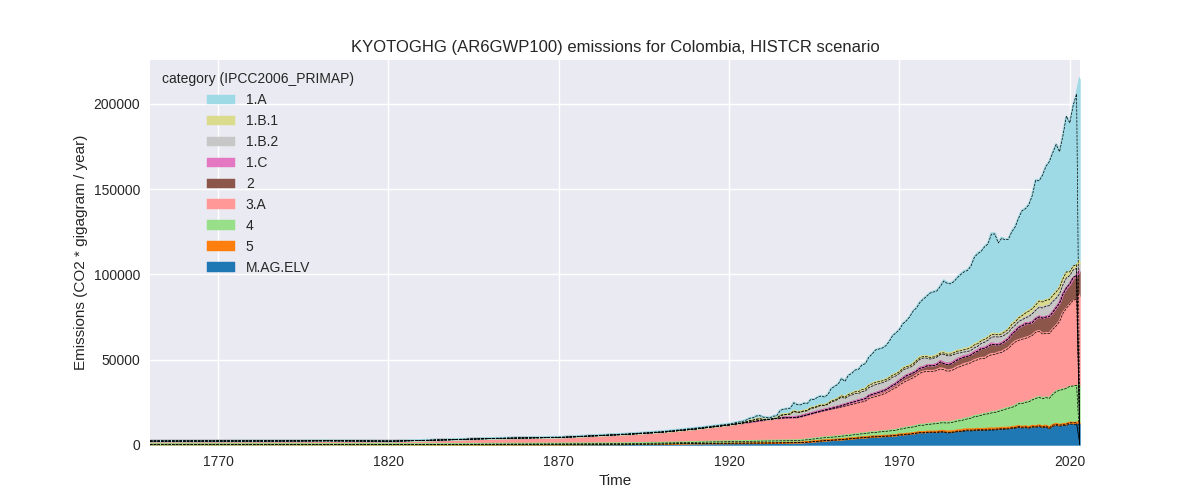
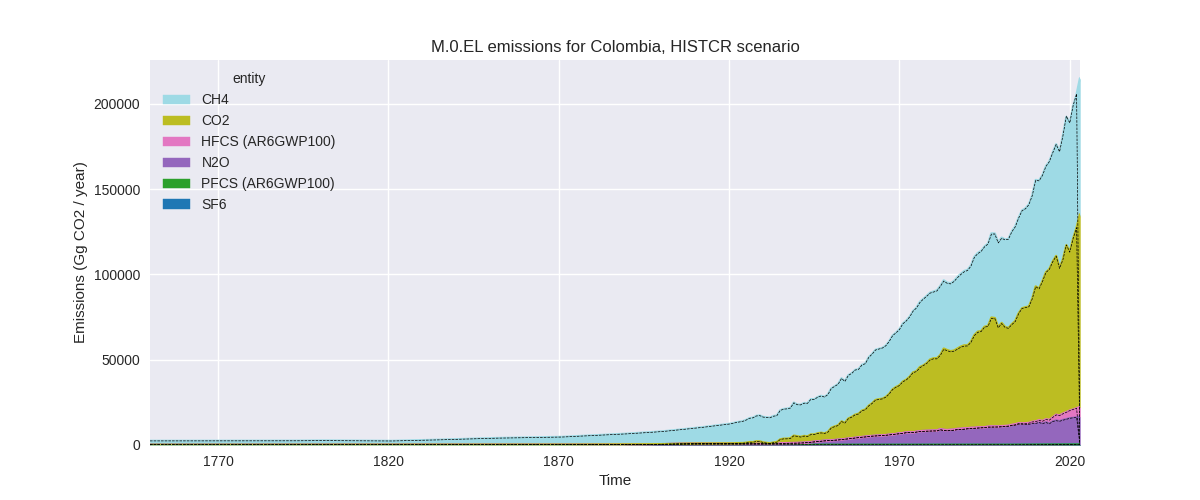
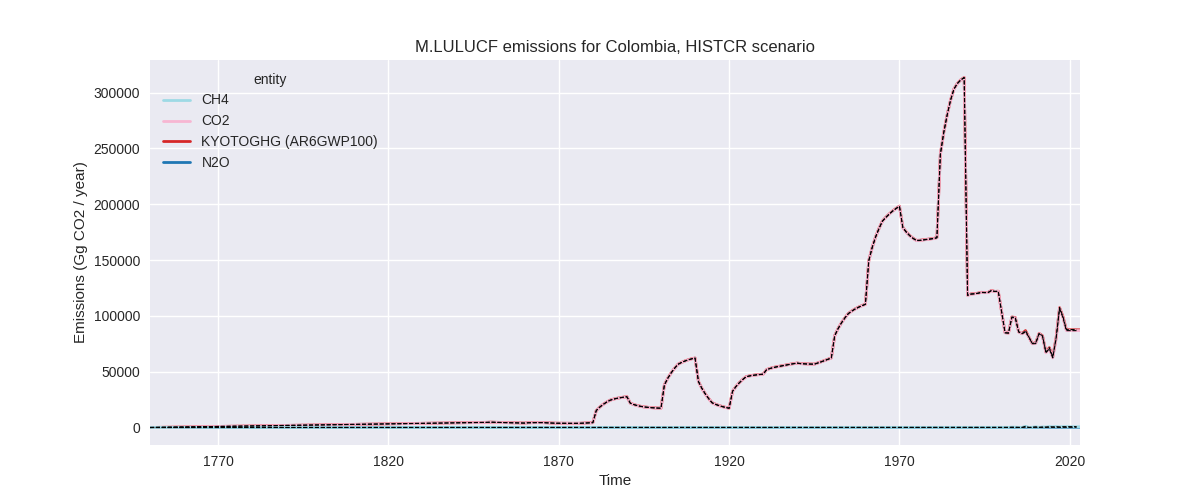
The following figures show the aggregate national total emissions excluding LULUCF AR6GWP100 for the third party priority scenario. The dotted linesshow the v2.5.1_final data.
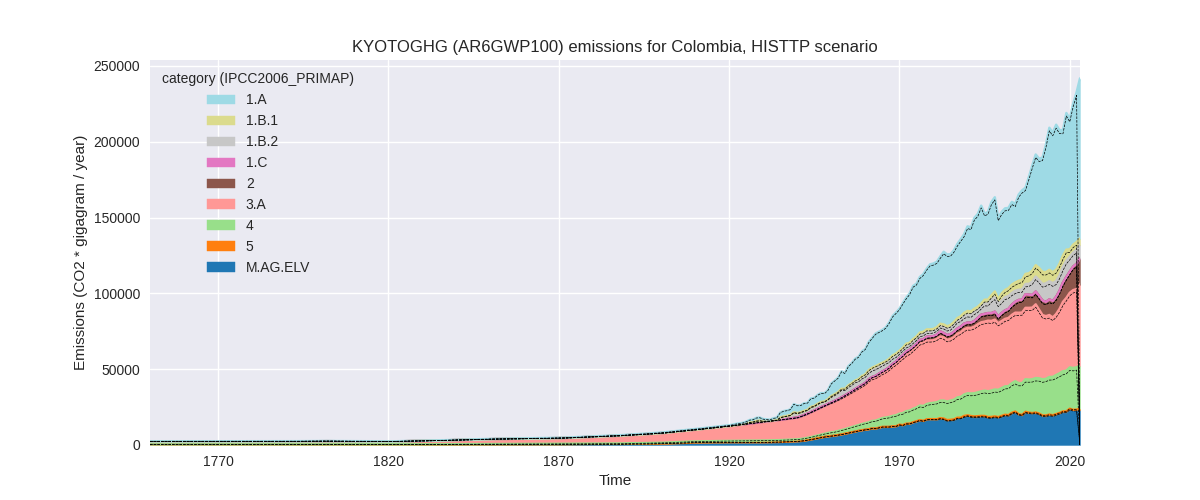
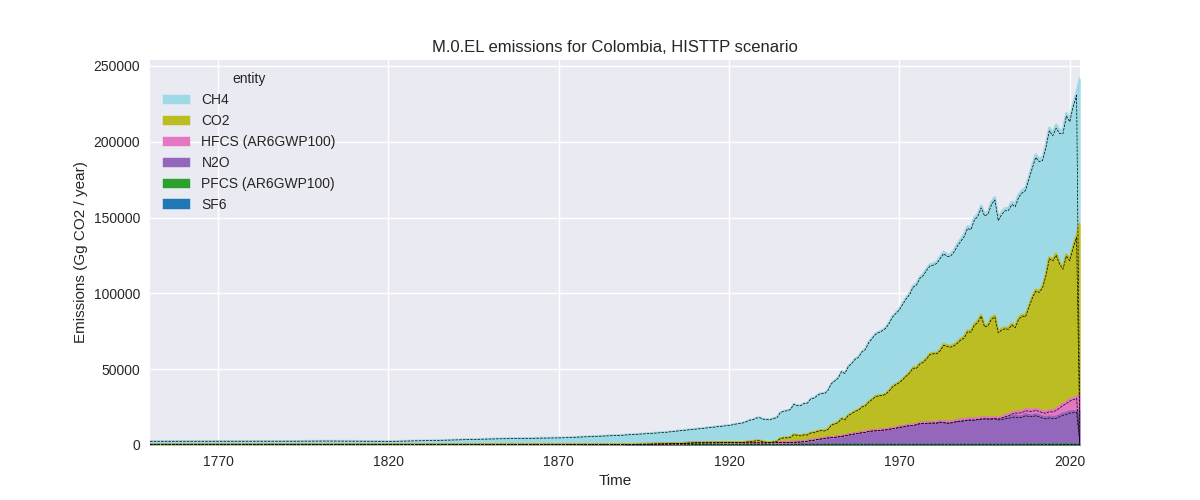
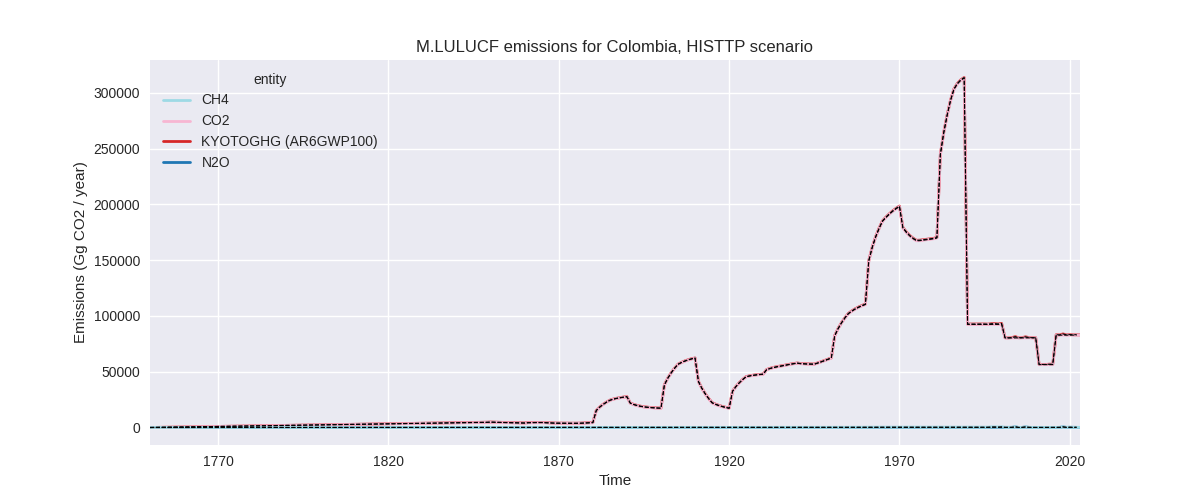
Overview over changes
In the country reported priority scenario we have the following changes for aggregate Kyoto GHG and national total emissions excluding LULUCF (M.0.EL):
- Emissions in 2022 have changed by -0.2%% (-457.04 Gg CO2 / year)
- Emissions in 1990-2022 have changed by 0.1%% (121.13 Gg CO2 / year)
In the third party priority scenario we have the following changes for aggregate Kyoto GHG and national total emissions excluding LULUCF (M.0.EL):
- Emissions in 2022 have changed by 0.9%% (2061.65 Gg CO2 / year)
- Emissions in 1990-2022 have changed by 1.0%% (1831.22 Gg CO2 / year)
Most important changes per scenario and time frame
In the country reported priority scenario the following sector-gas combinations have the highest absolute impact on national total KyotoGHG (AR6GWP100) emissions in 2022 (top 5):
- 1: 4, CH4 with -347.44 Gg CO2 / year (-1.7%)
- 2: 5, N2O with -107.42 Gg CO2 / year (-10.9%)
- 3: 1.A, CO2 with -31.73 Gg CO2 / year (-0.0%)
- 4: 1.B.2, CO2 with 20.61 Gg CO2 / year (1.5%)
- 5: 4, N2O with 15.16 Gg CO2 / year (2.0%)
In the country reported priority scenario the following sector-gas combinations have the highest absolute impact on national total KyotoGHG (AR6GWP100) emissions in 1990-2022 (top 5):
- 1: 5, N2O with 166.46 Gg CO2 / year (29.2%)
- 2: 4, CH4 with -38.26 Gg CO2 / year (-0.3%)
- 3: 1.B.2, CO2 with -11.20 Gg CO2 / year (-0.5%)
- 4: 4, N2O with 1.98 Gg CO2 / year (0.3%)
- 5: 1.A, CO2 with -0.85 Gg CO2 / year (-0.0%)
In the third party priority scenario the following sector-gas combinations have the highest absolute impact on national total KyotoGHG (AR6GWP100) emissions in 2022 (top 5):
- 1: 4, CH4 with 1035.15 Gg CO2 / year (4.1%)
- 2: 4, N2O with 994.46 Gg CO2 / year (155.2%)
- 3: 2, HFCS (AR6GWP100) with 134.55 Gg CO2 / year (1.5%)
- 4: 5, N2O with -107.42 Gg CO2 / year (-10.9%)
- 5: 1.A, CO2 with -31.89 Gg CO2 / year (-0.0%)
In the third party priority scenario the following sector-gas combinations have the highest absolute impact on national total KyotoGHG (AR6GWP100) emissions in 1990-2022 (top 5):
- 1: 4, CH4 with 967.58 Gg CO2 / year (5.1%)
- 2: 4, N2O with 691.43 Gg CO2 / year (142.2%)
- 3: 5, N2O with 166.46 Gg CO2 / year (29.2%)
- 4: 2, HFCS (AR6GWP100) with 4.08 Gg CO2 / year (0.1%)
- 5: 1.B.2, CO2 with -1.04 Gg CO2 / year (-0.1%)
Notes on data changes
Here we list notes explaining important emissions changes for the country. ’' means that the following text only applies to the TP time series, while means that it only applies to the CR scenario. Otherwise the note applies to both scenarios.
- There is no new country reported data and emissions estimates are almost identical to PRIMAP-hist v2.5.1. Only Energy CO2 and fugitive CO2 from oil and gas (flaring) have slight changes due to updated EI data.
- In the third party scenario the 2022 changes in flaring emissions are a bit higher but overall emission changes are still below 0.05%.
Changes by sector and gas
For each scenario and time frame the changes are displayed for all individual sectors and all individual gases. In the sector plot we use aggregate Kyoto GHGs in AR6GWP100. In the gas plot we usenational total emissions without LULUCF. ## country reported scenario
2022
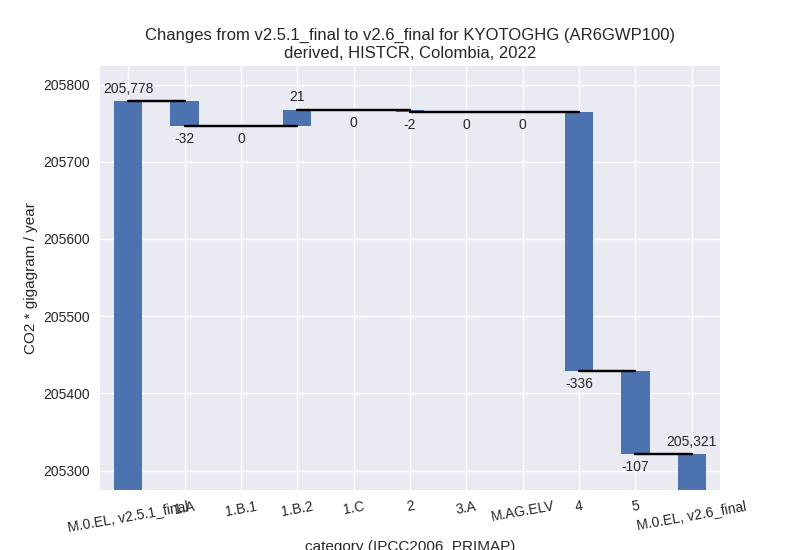
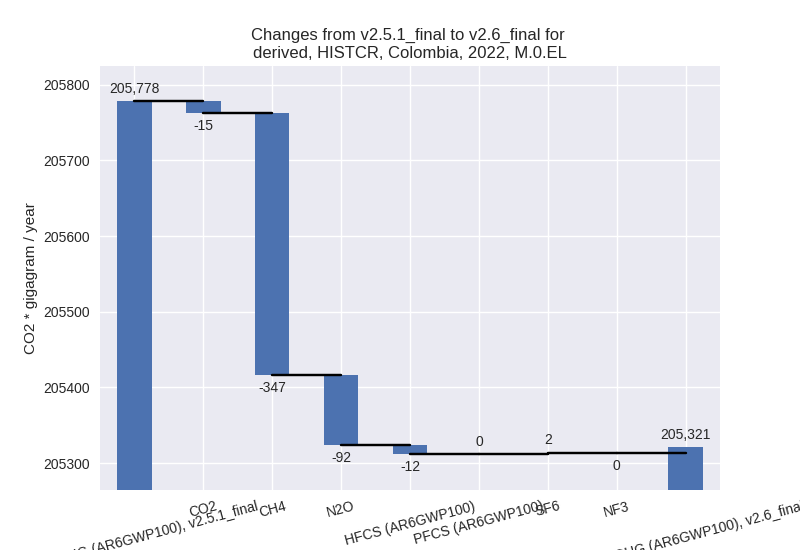
1990-2022
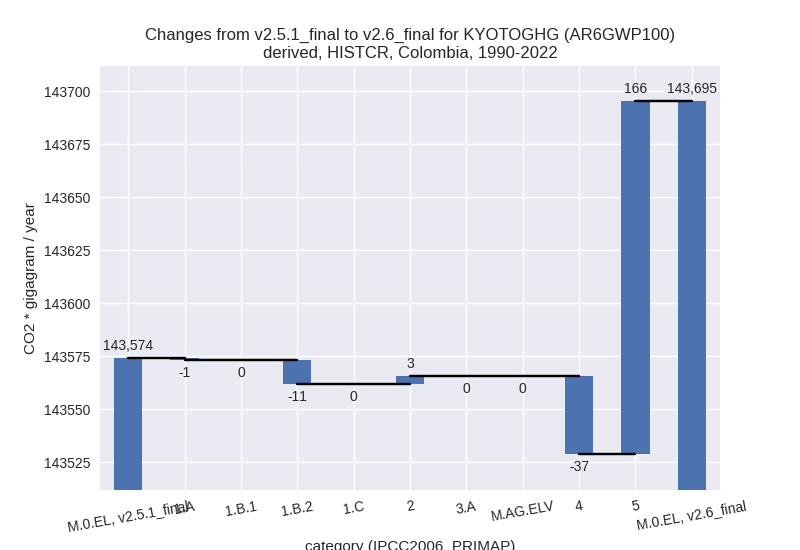
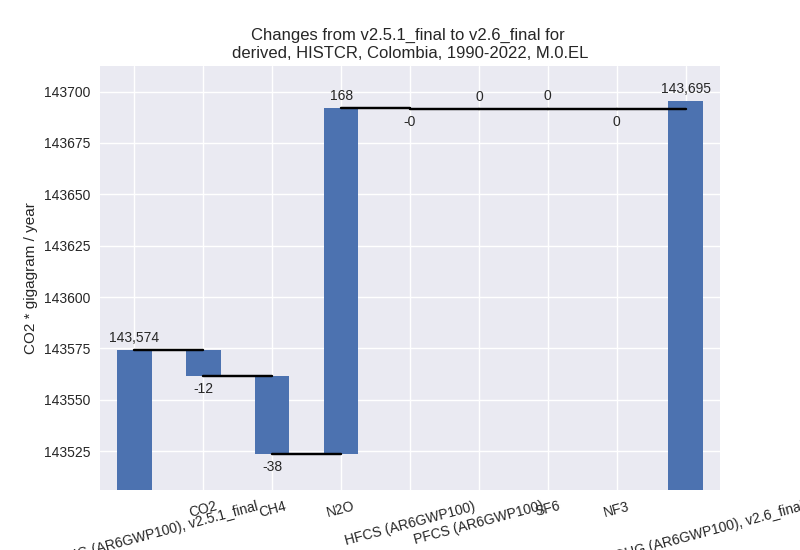
third party scenario
2022
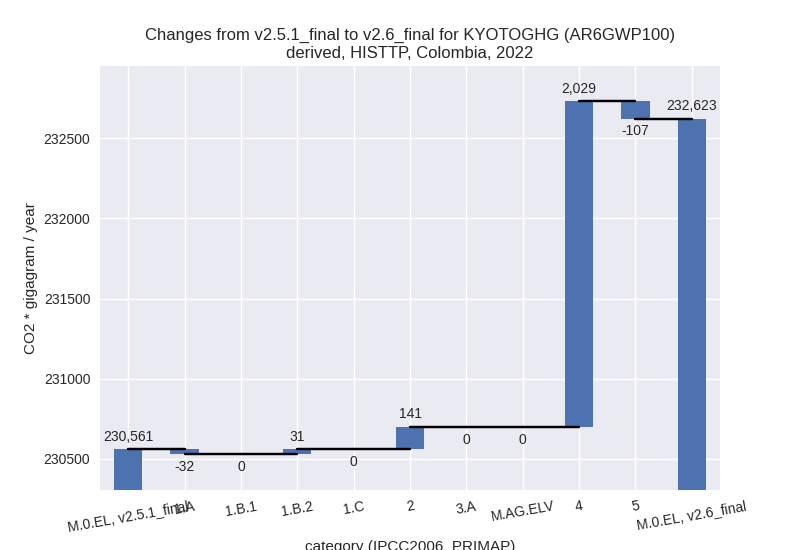
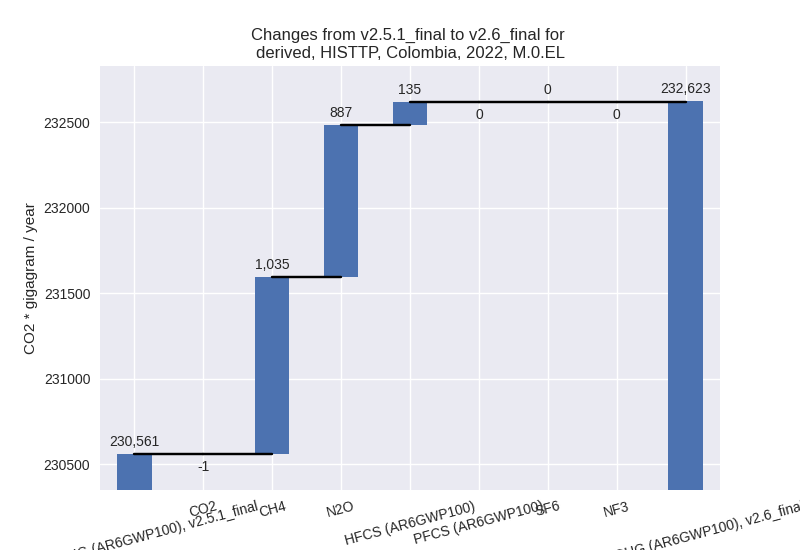
1990-2022
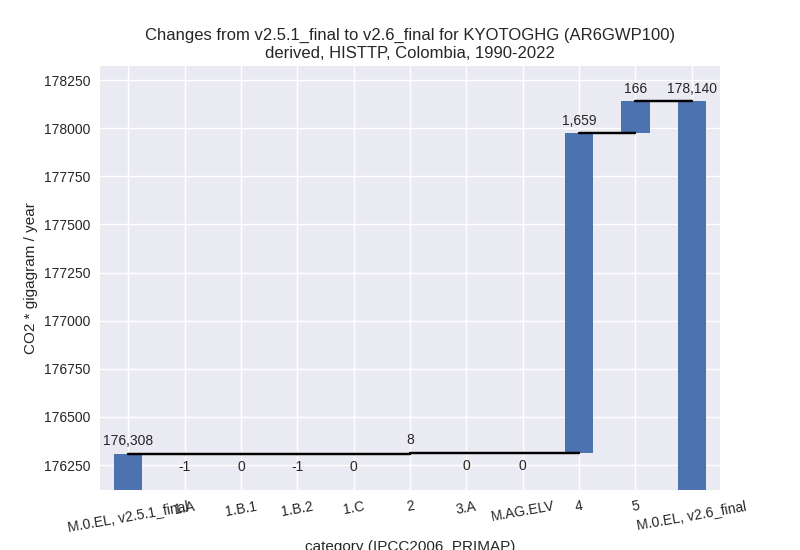
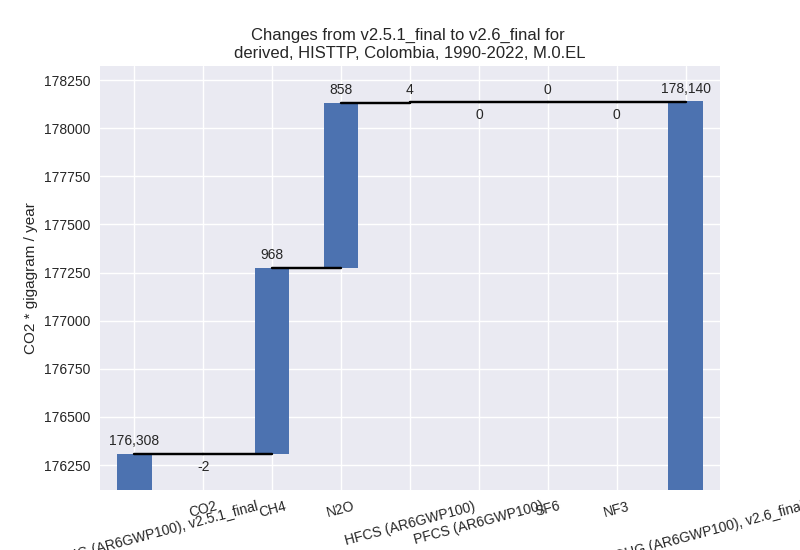
Detailed changes for the scenarios:
country reported scenario (HISTCR):
Most important changes per time frame
For 2022 the following sector-gas combinations have the highest absolute impact on national total KyotoGHG (AR6GWP100) emissions in 2022 (top 5):
- 1: 4, CH4 with -347.44 Gg CO2 / year (-1.7%)
- 2: 5, N2O with -107.42 Gg CO2 / year (-10.9%)
- 3: 1.A, CO2 with -31.73 Gg CO2 / year (-0.0%)
- 4: 1.B.2, CO2 with 20.61 Gg CO2 / year (1.5%)
- 5: 4, N2O with 15.16 Gg CO2 / year (2.0%)
For 1990-2022 the following sector-gas combinations have the highest absolute impact on national total KyotoGHG (AR6GWP100) emissions in 1990-2022 (top 5):
- 1: 5, N2O with 166.46 Gg CO2 / year (29.2%)
- 2: 4, CH4 with -38.26 Gg CO2 / year (-0.3%)
- 3: 1.B.2, CO2 with -11.20 Gg CO2 / year (-0.5%)
- 4: 4, N2O with 1.98 Gg CO2 / year (0.3%)
- 5: 1.A, CO2 with -0.85 Gg CO2 / year (-0.0%)
Changes in the main sectors for aggregate KyotoGHG (AR6GWP100) are
- 1: Total sectoral emissions in 2022 are 106280.54 Gg CO2 / year which is 51.8% of M.0.EL emissions. 2022 Emissions have changed by -0.0% (-11.12 Gg CO2 / year). 1990-2022 Emissions have changed by -0.0% (-12.05 Gg CO2 / year).
- 2: Total sectoral emissions in 2022 are 14052.05 Gg CO2 / year which is 6.8% of M.0.EL emissions. 2022 Emissions have changed by -0.0% (-2.33 Gg CO2 / year). 1990-2022 Emissions have changed by 0.0% (3.40 Gg CO2 / year).
- M.AG: Total sectoral emissions in 2022 are 62570.98 Gg CO2 / year which is 30.5% of M.0.EL emissions. 2022 Emissions have changed by 0.0% (0.00 Gg CO2 / year). 1990-2022 Emissions have changed by 0.0% (0.00 Gg CO2 / year).
- 4: Total sectoral emissions in 2022 are 21541.09 Gg CO2 / year which is 10.5% of M.0.EL emissions. 2022 Emissions have changed by -1.5% (-336.17 Gg CO2 / year). 1990-2022 Emissions have changed by -0.3% (-36.69 Gg CO2 / year).
- 5: Total sectoral emissions in 2022 are 876.55 Gg
CO2 / year which is 0.4% of M.0.EL emissions. 2022 Emissions have
changed by -10.9% (-107.42 Gg CO2 /
year). 1990-2022 Emissions have changed by 29.2% (166.46 Gg CO2 / year). For 2022 the
changes per gas
are:
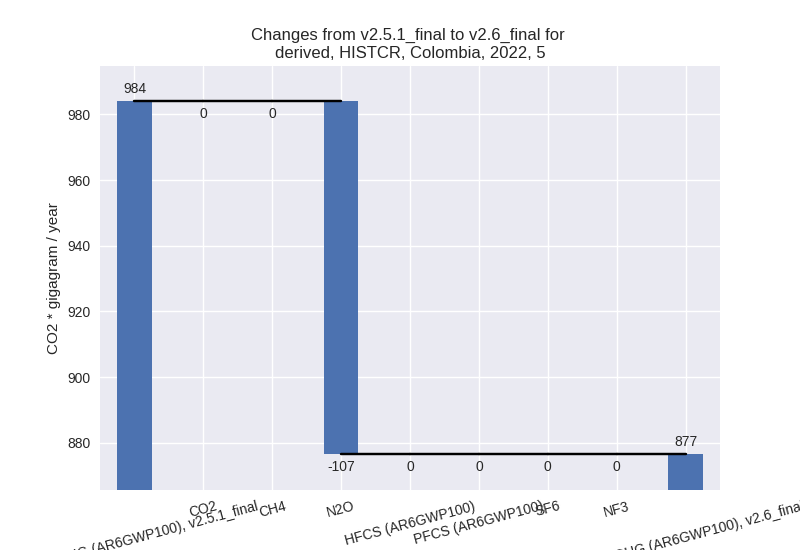
For 1990-2022 the changes per gas are: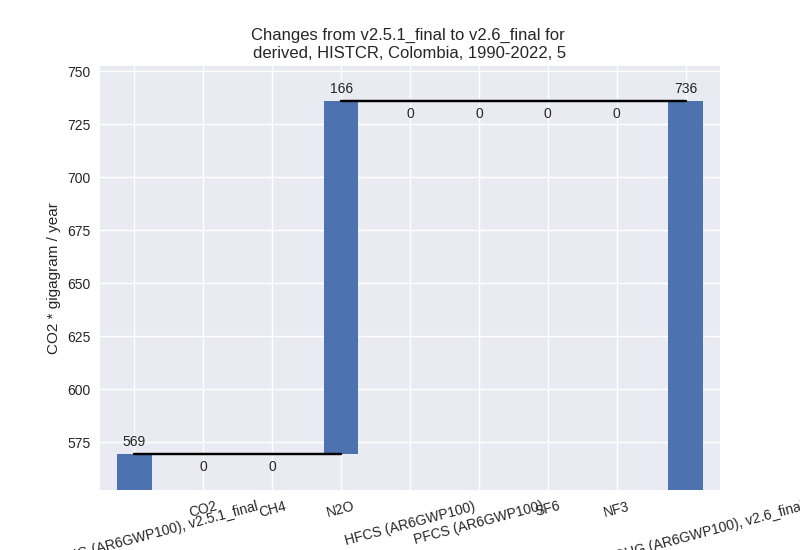
third party scenario (HISTTP):
Most important changes per time frame
For 2022 the following sector-gas combinations have the highest absolute impact on national total KyotoGHG (AR6GWP100) emissions in 2022 (top 5):
- 1: 4, CH4 with 1035.15 Gg CO2 / year (4.1%)
- 2: 4, N2O with 994.46 Gg CO2 / year (155.2%)
- 3: 2, HFCS (AR6GWP100) with 134.55 Gg CO2 / year (1.5%)
- 4: 5, N2O with -107.42 Gg CO2 / year (-10.9%)
- 5: 1.A, CO2 with -31.89 Gg CO2 / year (-0.0%)
For 1990-2022 the following sector-gas combinations have the highest absolute impact on national total KyotoGHG (AR6GWP100) emissions in 1990-2022 (top 5):
- 1: 4, CH4 with 967.58 Gg CO2 / year (5.1%)
- 2: 4, N2O with 691.43 Gg CO2 / year (142.2%)
- 3: 5, N2O with 166.46 Gg CO2 / year (29.2%)
- 4: 2, HFCS (AR6GWP100) with 4.08 Gg CO2 / year (0.1%)
- 5: 1.B.2, CO2 with -1.04 Gg CO2 / year (-0.1%)
Changes in the main sectors for aggregate KyotoGHG (AR6GWP100) are
- 1: Total sectoral emissions in 2022 are 113141.71 Gg CO2 / year which is 48.6% of M.0.EL emissions. 2022 Emissions have changed by -0.0% (-1.12 Gg CO2 / year). 1990-2022 Emissions have changed by -0.0% (-1.89 Gg CO2 / year).
- 2: Total sectoral emissions in 2022 are 16641.83 Gg CO2 / year which is 7.2% of M.0.EL emissions. 2022 Emissions have changed by 0.9% (140.73 Gg CO2 / year). 1990-2022 Emissions have changed by 0.1% (7.65 Gg CO2 / year).
- M.AG: Total sectoral emissions in 2022 are 73992.31 Gg CO2 / year which is 31.8% of M.0.EL emissions. 2022 Emissions have changed by 0.0% (0.00 Gg CO2 / year). 1990-2022 Emissions have changed by 0.0% (0.00 Gg CO2 / year).
- 4: Total sectoral emissions in 2022 are 27970.17 Gg
CO2 / year which is 12.0% of M.0.EL emissions. 2022 Emissions have
changed by 7.8% (2029.47 Gg CO2 /
year). 1990-2022 Emissions have changed by 8.5% (1659.00 Gg CO2 / year). For 2022 the
changes per gas
are:
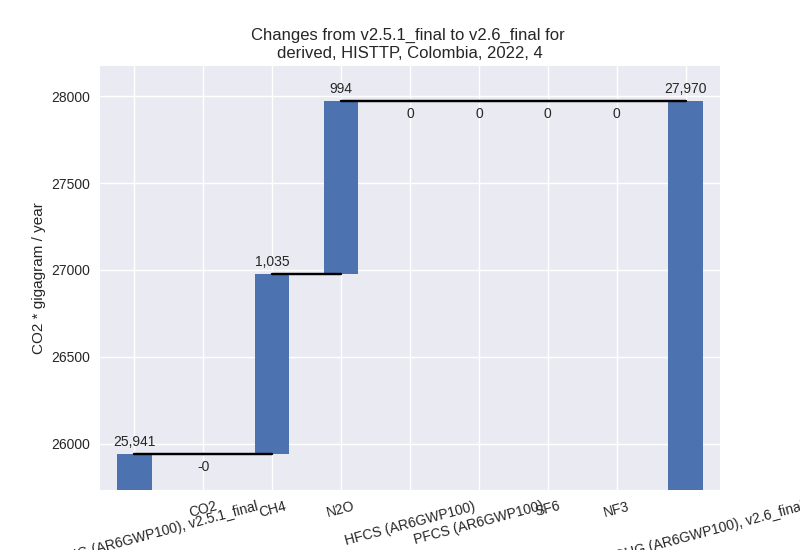
For 1990-2022 the changes per gas are:
- 5: Total sectoral emissions in 2022 are 876.55 Gg
CO2 / year which is 0.4% of M.0.EL emissions. 2022 Emissions have
changed by -10.9% (-107.42 Gg CO2 /
year). 1990-2022 Emissions have changed by 29.2% (166.46 Gg CO2 / year). For 2022 the
changes per gas
are:
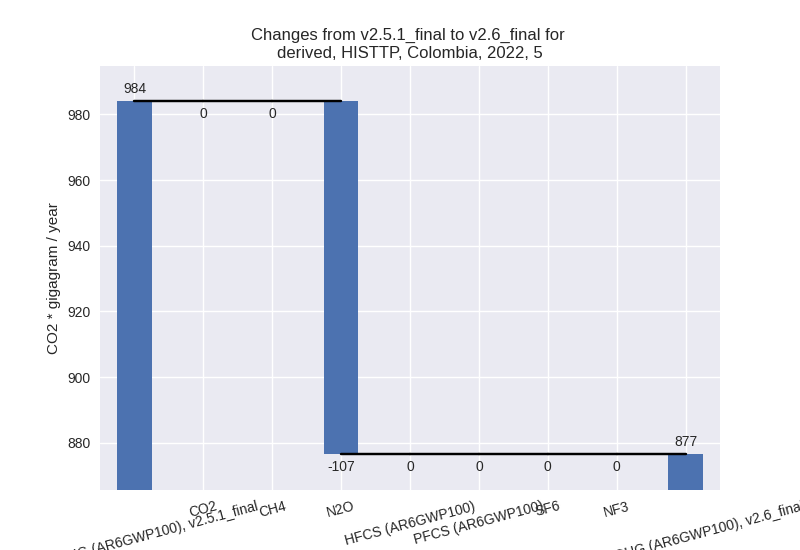
For 1990-2022 the changes per gas are: